Evaluation of a Non-Aqueous Vanadium Redox Flow Battery Using a Deep Eutectic Solvent and Graphene-Modified Carbon Electrodes via Electrophoretic Deposition
Abstract
1. Introduction
2. Experimental
2.1. Chemicals
2.2. Materials
2.3. Nitrogen Doping of Graphene
2.4. Physicochemical Properties
2.5. Electrophoretic Deposition (EPD)
2.6. Membrane-Electrode-Assembly (MEA)
2.7. Morphological Analysis
2.8. Electrochemical Setup for CV
2.9. Redox Flow Battery Cell Assembly
2.10. Charge–Discharge Experiments
3. Results and Discussion
3.1. Physicochemical Properties of DES and IL
3.2. Cyclic Voltammetry of V(acac)3 in IL and DES with Glass Carbon (GC) Working Electrode
3.3. Cyclic Voltammetry of V(acac)3 in IL and DES with Pristine and N-G-Modified CP Electrodes
3.4. Charge/Discharge of V(acac)3 in IL and DES
3.5. Charge/Discharge of V(acac)3 in DES at Different Current Densities and RFB Cycling Performance
3.6. Electrochemical Impedance Spectroscopy of IL and DES in an Operational RFB
3.7. Morphological Characterization of CP Electrodes
3.8. Brief Perspective for Scaling-Up DES-Based RFBs
4. Conclusions
Supplementary Materials
Author Contributions
Funding
Acknowledgments
Conflicts of Interest
References
- Leung, P.; Li, X.; Ponce de León, C.; Berlouis, L.; Low, C.T.J.; Walsh, F.C. Progress in redox flow batteries, remaining challenges and their applications in energy storage. RSC Adv. 2012, 2, 10125–10156. [Google Scholar] [CrossRef]
- Chen, C.L.; Yeoh, H.K.; Chakrabarti, M.H. One Dimensional Mathematical Modelling of the All-Vanadium and Vanadium/Oxygen Redox Flow Batteries. ECS Trans. 2015, 66, 1–23. [Google Scholar] [CrossRef]
- Ghimire, P.C.; Bhattarai, A.; Schweiss, R.; Scherer, G.G.; Wai, N.; Lim, T.M.; Yan, Q. Investigation of reactant conversion in the vanadium redox flow battery using spatially resolved state of charge mapping. Batteries 2019, 5, 2. [Google Scholar] [CrossRef]
- Bae, C.; Chakrabarti, H.; Roberts, E. A membrane free electrochemical cell using porous flow-through graphite felt electrodes. J. Appl. Electrochem. 2008, 38, 637–644. [Google Scholar] [CrossRef]
- Pino-Muñoz, C.A.; Chakrabarti, B.K.; Yufit, V.; Brandon, N.P. Characterization of a Regenerative hydrogen-vanadium fuel cell using an experimentally validated unit cell model. J. Electrochem. Soc. 2019, 166, A3511–A3524. [Google Scholar] [CrossRef]
- Chakrabarti, M.H.; Hajimolana, S.A.; Mjalli, F.S.; Saleem, M.; Mustafa, I. Redox flow battery for energy storage. Arab. J. Sci. Eng. 2013, 38, 723–739. [Google Scholar] [CrossRef]
- Tariq, F.; Rubio-Garcia, J.; Yufit, V.; Bertei, A.; Chakrabarti, B.K.; Kucernak, A.; Brandon, N. Uncovering the mechanisms of electrolyte permeation in porous electrodes for redox flow batteries through real time in situ 3D imaging. Sustain. Energy Fuels 2018, 2, 2068–2080. [Google Scholar] [CrossRef]
- Jiang, H.R.; Sun, J.; Wei, L.; Wu, M.C.; Shyy, W.; Zhao, T.S. A high power density and long cycle life vanadium redox flow battery. Energy Stor. Mater. 2020, 24, 529–540. [Google Scholar] [CrossRef]
- Ibrahim, O.A.; Kjeang, E. Leveraging co-laminar flow cells for non-aqueous electrochemical systems. J. Power Sources 2018, 402, 7–14. [Google Scholar] [CrossRef]
- Chakrabarti, M.H.; Dryfe, R.A.W.; Roberts, E.P.L. Evaluation of electrolytes for redox flow battery applications. Electrochim. Acta 2007, 52, 2189–2195. [Google Scholar] [CrossRef]
- Bamgbopa, M.O.; Pour, N.; Shao-Horn, Y.; Almheiri, S. Systematic selection of solvent mixtures for non-aqueous redox flow batteries – vanadium acetylacetonate as a model system. Electrochim. Acta 2017, 223, 115–123. [Google Scholar] [CrossRef]
- Herr, T.; Noack, J.; Fischer, P.; Tübke, J. 1,3-Dioxolane, tetrahydrofuran, acetylacetone and dimethyl sulfoxide as solvents for non-aqueous vanadium acetylacetonate redox-flow-batteries. Electrochim. Acta 2013, 113, 127–133. [Google Scholar] [CrossRef]
- Bamgbopa, M.O.; Almheiri, S. Influence of solvents on species crossover and capacity decay in non-aqueous vanadium redox flow batteries: Characterization of acetonitrile and 1, 3 dioxolane solvent mixture. J. Power Sources 2017, 342, 371–381. [Google Scholar] [CrossRef]
- Ejigu, A.; Greatorex-Davies, P.A.; Walsh, D.A. Room temperature ionic liquid electrolytes for redox flow batteries. Electrochem. Commun. 2015, 54, 55–59. [Google Scholar] [CrossRef]
- Bahadori, L.; Chakrabarti, M.H.; Hashim, M.A.; Manan, N.S.A.; Mjalli, F.S.; AlNashef, I.M.; Brandon, N.P. Temperature effects on the kinetics of ferrocene and cobaltocenium in methyltriphenylphosphonium bromide based deep eutectic solvents. J. Electrochem. Soc. 2015, 162, H617–H624. [Google Scholar] [CrossRef]
- Ge, X.; Gu, C.; Wang, X.; Tu, J. Deep eutectic solvents (DESs)-derived advanced functional materials for energy and environmental applications: Challenges, opportunities, and future vision. J. Mater. Chem. A 2017, 5, 8209–8229. [Google Scholar] [CrossRef]
- Kim, J.-H.; Ryu, S.; Maurya, S.; Lee, J.-Y.; Sung, K.-W.; Lee, J.-S.; Moon, S.-H. Fabrication of a composite anion exchange membrane with aligned ion channels for a high-performance non-aqueous vanadium redox flow battery. RSC Adv. 2020, 10, 5010–5025. [Google Scholar] [CrossRef]
- Karmakar, A.; Mukundan, R.; Yang, P.; Batista, E.R. Solubility model of metal complex in ionic liquids from first principle calculations. RSC Adv. 2019, 9, 18506–18526. [Google Scholar] [CrossRef]
- Wang, Y.; Niu, Z.; Zheng, Q.; Zhang, C.; Ye, J.; Dai, G.; Zhao, Y.; Zhang, X. Zn-based eutectic mixture as anolyte for hybrid redox flow batteries. Sci. Rep. 2018, 8, 5740. [Google Scholar] [CrossRef] [PubMed]
- Zhang, C.; Ding, Y.; Zhang, L.; Wang, X.; Zhao, Y.; Zhang, X.; Yu, G. A sustainable redox-flow battery with an aluminum-based, deep-eutectic-solvent anolyte. Angew. Chem. Int. Ed. 2017, 56, 7454–7459. [Google Scholar] [CrossRef]
- Xu, Q.; Qin, L.Y.; Ji, Y.N.; Leung, P.K.; Su, H.N.; Qiao, F.; Yang, W.W.; Shah, A.A.; Li, H.M. A deep eutectic solvent (DES) electrolyte-based vanadium-iron redox flow battery enabling higher specific capacity and improved thermal stability. Electrochim. Acta 2019, 293, 426–431. [Google Scholar] [CrossRef]
- Bahadori, L.; Chakrabarti, M.H.; Manan, N.S.A.; Hashim, M.A.; Mjalli, F.S.; AlNashef, I.M.; Brandon, N. The Effect of temperature on kinetics and diffusion coefficients of metallocene derivatives in polyol-based deep eutectic solvents. PLoS ONE 2015, 10, e0144235. [Google Scholar] [CrossRef]
- Chakrabarti, M.H.; Mjalli, F.S.; AlNashef, I.M.; Hashim, M.A.; Hussain, M.A.; Bahadori, L.; Low, C.T.J. Prospects of applying ionic liquids and deep eutectic solvents for renewable energy storage by means of redox flow batteries. Renew. Sustain. Energ. Rev. 2014, 30, 254–270. [Google Scholar] [CrossRef]
- Gencten, M.; Sahin, Y. A critical review on progress of the electrode materials of vanadium redox flow battery. Int. J. Energy Res. 2020. [Google Scholar] [CrossRef]
- Zhang, D.; Forner-Cuenca, A.; Taiwo, O.O.; Yufit, V.; Brushett, F.R.; Brandon, N.P.; Gu, S.; Cai, Q. Understanding the role of the porous electrode microstructure in redox flow battery performance using an experimentally validated 3D pore-scale lattice Boltzmann model. J. Power Sources 2020, 447, 227249. [Google Scholar] [CrossRef]
- Jervis, R.; Kok, M.D.R.; Neville, T.P.; Meyer, Q.; Brown, L.D.; Iacoviello, F.; Gostick, J.T.; Brett, D.J.L.; Shearing, P.R. In Situ compression and X-ray computed tomography of flow battery electrodes. J. Energy Chem. 2018, 27, 1353–1361. [Google Scholar] [CrossRef]
- Chakrabarti, M.H.; Low, C.T.J.; Brandon, N.P.; Yufit, V.; Hashim, M.A.; Irfan, M.F.; Akhtar, J.; Ruiz-Trejo, E.; Hussain, M.A. Progress in the electrochemical modification of graphene-based materials and their applications. Electrochim. Acta 2013, 107, 425–440. [Google Scholar] [CrossRef]
- Flox, C.; Rubio-García, J.; Skoumal, M.; Andreu, T.; Morante, J.R. Thermo–chemical treatments based on NH3/O2 for improved graphite-based fiber electrodes in vanadium redox flow batteries. Carbon 2013, 60, 280–288. [Google Scholar] [CrossRef]
- Chakrabarti, M.H.; Brandon, N.P.; Hajimolana, S.A.; Tariq, F.; Yufit, V.; Hashim, M.A.; Hussain, M.A.; Low, C.T.J.; Aravind, P.V. Application of carbon materials in redox flow batteries. J. Power Sources 2014, 253, 150–166. [Google Scholar] [CrossRef]
- Chang, Y.-C.; Shih, Y.-C.; Chen, J.-Y.; Lin, G.-Y.; Hsu, N.-Y.; Chou, Y.-S.; Wang, C.-H. High efficiency of bamboo-like carbon nanotubes on functionalized graphite felt as electrode in vanadium redox flow battery. RSC Adv. 2016, 6, 102068–102075. [Google Scholar] [CrossRef]
- Chakrabarti, B.; Nir, D.; Yufit, V.; Aravind, P.V.; Brandon, N. Enhanced performance of an All-Vanadium redox flow battery employing graphene modified carbon paper electrodes. Int. J. Chem. Mol. Eng. 2017, 11, 622–626. [Google Scholar]
- Chakrabarti, B.; Yufit, V.; Kavei, A.; Xia, Y.; Stevenson, G.; Kalamaras, E.; Luo, H.; Feng, J.; Tariq, F.; Taiwo, O.; et al. Charge/discharge and cycling performance of flexible carbon paper electrodes in a regenerative hydrogen/vanadium fuel cell. Int. J. Hydrog. Energy 2019, 44, 30093–30107. [Google Scholar] [CrossRef]
- Cao, J.; Zhu, Z.; Xu, J.; Tao, M.; Chen, Z. Nitrogen-doped porous graphene as a highly efficient cathodic electrocatalyst for aqueous organic redox flow battery application. J. Mater. Chem. A 2017, 5, 7944–7951. [Google Scholar] [CrossRef]
- Cao, J.; Ding, F.; Chen, H.; Wang, H.; Wang, W.; Chen, Z.; Xu, J. A new redox-active conjugated polymer containing anthraquinone pendants as anode material for aqueous all-organic hybrid-flow battery. J. Power Sources 2019, 423, 316–322. [Google Scholar] [CrossRef]
- Zhang, Y.; Liu, W.; Wang, Z.; Shen, Y.-M.; Wang, W.; Chen, Z.; Xu, J.; Cao, J. Tetrapyridophenazine/graphene composites for aqueous hybrid flow battery anodes with long cycle life. Carbon 2020, 161, 309–315. [Google Scholar] [CrossRef]
- Yang, D.-S.; Lee, J.Y.; Jo, S.-W.; Yoon, S.J.; Kim, T.-H.; Hong, Y.T. Electrocatalytic activity of nitrogen-doped CNT graphite felt hybrid for all-vanadium redox flow batteries. Int. J. Hydrog. Energy 2018, 43, 1516–1522. [Google Scholar] [CrossRef]
- Bahadori, L.; Hashim, M.A.; Manan, N.S.A.; Mjalli, F.S.; AlNashef, I.M.; Brandon, N.P.; Chakrabarti, M.H. Investigation of Ammonium- and phosphonium-based deep eutectic solvents as electrolytes for a Non-aqueous All-Vanadium redox cell. J. Electrochem. Soc. 2016, 163, A632–A638. [Google Scholar] [CrossRef]
- Chakrabarti, M.H.; Manan, N.S.A.; Brandon, N.P.; Maher, R.C.; Mjalli, F.S.; AlNashef, I.M.; Hajimolana, S.A.; Hashim, M.A.; Hussain, M.A.; Nir, D. One-pot electrochemical gram-scale synthesis of graphene using deep eutectic solvents and acetonitrile. Chem. Eng. J. 2015, 274, 213–223. [Google Scholar] [CrossRef]
- Lloyd, D.; Vainikka, T.; Kontturi, K. The development of an all copper hybrid redox flow battery using deep eutectic solvents. Electrochim. Acta 2013, 100, 18–23. [Google Scholar] [CrossRef]
- Park, S.K.; Oh, C.J.; Kim, S.-G.; Lee, B.-J.; Lee, J.H.; Lee, J.S. Effect of functionalized ionic liquids on the stability of V(acac)3. B. Korean Chem. Soc. 2018, 39, 1036–1040. [Google Scholar] [CrossRef]
- Xing, Z.; Ju, Z.; Zhao, Y.; Wan, J.; Zhu, Y.; Qiang, Y.; Qian, Y. One-pot hydrothermal synthesis of Nitrogen-doped graphene as high-performance anode materials for lithium ion batteries. Sci. Rep. 2016, 6, 26146. [Google Scholar] [CrossRef] [PubMed]
- Chakrabarti, B.; Nir, D.; Yufit, V.; Tariq, F.; Rubio-Garcia, J.; Maher, R.; Kucernak, A.; Aravind, P.V.; Brandon, N. Performance enhancement of reduced graphene Oxide-Modified carbon electrodes for vanadium redox-flow systems. ChemElectroChem 2017, 4, 194–200. [Google Scholar] [CrossRef]
- Wu, Y.; Holze, R. Electrocatalysis at Electrodes for Vanadium Redox Flow Batteries. Batteries 2018, 4, 47. [Google Scholar] [CrossRef]
- Tariq, F.; Yufit, V.; Kishimoto, M.; Shearing, P.R.; Menkin, S.; Golodnitsky, D.; Gelb, J.; Peled, E.; Brandon, N.P. Three-dimensional high resolution X-ray imaging and quantification of lithium ion battery mesocarbon microbead anodes. J. Power Sources 2014, 248, 1014–1020. [Google Scholar] [CrossRef]
- Chakrabarti, M.H.; Brandon, N.P.; Mjalli, F.S.; Bahadori, L.; Al Nashef, I.M.; Hashim, M.A.; Hussain, M.A.; Low, C.T.J.; Yufit, V. Cyclic Voltammetry of Metallic Acetylacetonate Salts in Quaternary Ammonium and Phosphonium Based Deep Eutectic Solvents. J. Solut. Chem. 2013, 42, 2329–2341. [Google Scholar] [CrossRef]
- Rubio-Garcia, J.; Kucernak, A.; Parra-Puerto, A.; Liu, R.; Chakrabarti, B. Hydrogen/functionalized benzoquinone for a high-performance regenerative fuel cell as a potential large-scale energy storage platform. J. Mater. Chem. A 2020, 8, 3933–3941. [Google Scholar] [CrossRef]
- Chakrabarti, M.H.; Brandon, N.P.; Hashim, M.A.; Mjalli, F.S.; AlNashef, I.M.; Bahadori, L.; Manan, N.S.A.; Hussain, M.; Yufit, V. Cyclic voltammetry of iron (III) acetylacetonate in quaternary ammonium and phosphonium based deep eutectic solvents. Int. J. Electrochem. Sci. 2013, 8, 9652–9676. [Google Scholar]
- Shinkle, A.A.; Pomaville, T.J.; Sleightholme, A.E.S.; Thompson, L.T.; Monroe, C.W. Solvents and supporting electrolytes for vanadium acetylacetonate flow batteries. J. Power Sources 2014, 248, 1299–1305. [Google Scholar] [CrossRef]
- Marszalek, M.; Fei, Z.; Zhu, D.-R.; Scopelliti, R.; Dyson, P.J.; Zakeeruddin, S.M.; Grätzel, M. Application of ionic liquids containing tricyanomethanide [C(CN)3]− or Tetracyanoborate [B(CN)4]− Anions in Dye-sensitized solar cells. Inorg. Chem. 2011, 50, 11561–11567. [Google Scholar] [CrossRef]
- Shinkle, A.A.; Sleightholme, A.E.S.; Griffith, L.D.; Thompson, L.T.; Monroe, C.W. Degradation mechanisms in the non-aqueous vanadium acetylacetonate redox flow battery. J. Power Sources 2012, 206, 490–496. [Google Scholar] [CrossRef]
- Chen, R.; Hempelmann, R. Ionic liquid-mediated aqueous redox flow batteries for high voltage applications. Electrochem. Commun. 2016, 70, 56–59. [Google Scholar] [CrossRef]
- Liu, Q.; Sleightholme, A.E.S.; Shinkle, A.A.; Li, Y.; Thompson, L.T. Non-aqueous vanadium acetylacetonate electrolyte for redox flow batteries. Electrochem. Commun. 2009, 11, 2312–2315. [Google Scholar] [CrossRef]
- Flox, C.; Skoumal, M.; Rubio-Garcia, J.; Andreu, T.; Morante, J.R. Strategies for enhancing electrochemical activity of carbon-based electrodes for all-vanadium redox flow batteries. Appl. Energy 2013, 109, 344–351. [Google Scholar] [CrossRef]
- Xu, Q.; Qin, L.; Su, H.; Xu, L.; Leung, P.; Yang, C.; Li, H. Electrochemical and transport characteristics of V(II)/V(III) Redox Couple in a nonaqueous deep eutectic solvent: Temperature effect. J. Energy Eng. 2017, 143, 04017051. [Google Scholar] [CrossRef]
- Xu, Q.; Ji, Y.N.; Qin, L.Y.; Leung, P.K.; Shah, A.A.; Li, Y.S.; Su, H.N.; Li, H.M. Effect of carbon dioxide additive on the characteristics of a deep eutectic solvent (DES) electrolyte for non-aqueous redox flow batteries. Chem. Phys. Lett. 2018, 708, 48–53. [Google Scholar] [CrossRef]
- Ma, Q.; Xu, Q.; Chen, Q.; Chen, Z.; Su, H.; Zhang, W. Lattice Boltzmann model for complex transfer behaviors in porous electrode of all copper redox flow battery with deep eutectic solvent electrolyte. Appl. Therm. Eng. 2019, 160, 114015. [Google Scholar] [CrossRef]
- Abbas, Q.; Fitzek, H.; Pavlenko, V.; Gollas, B. Towards an optimized hybrid electrochemical capacitor in iodide based aqueous redox-electrolyte: Shift of equilibrium potential by electrodes mass-balancing. Electrochim. Acta 2020, 337, 135785. [Google Scholar] [CrossRef]
- Barton, J.L.; Brushett, F.R. A One-Dimensional stack model for redox flow battery analysis and operation. Batteries 2019, 5, 25. [Google Scholar] [CrossRef]
- Naik, P.K.; Paul, S.; Banerjee, T. Physiochemical properties and molecular dynamics simulations of phosphonium and ammonium based deep eutectic solvents. J. Solut. Chem. 2019, 48, 1046–1065. [Google Scholar] [CrossRef]
- Kawase, K.; Abe, J.; Tenjimbayashi, M.; Kobayashi, Y.; Takahashi, K.; Shiratori, S. Novel Deep-Eutectic-Solvent-Infused carbon nanofiber networks as high power density green battery cathodes. ACS Appl. Mater. Interfaces 2018, 10, 15742–15750. [Google Scholar] [CrossRef]
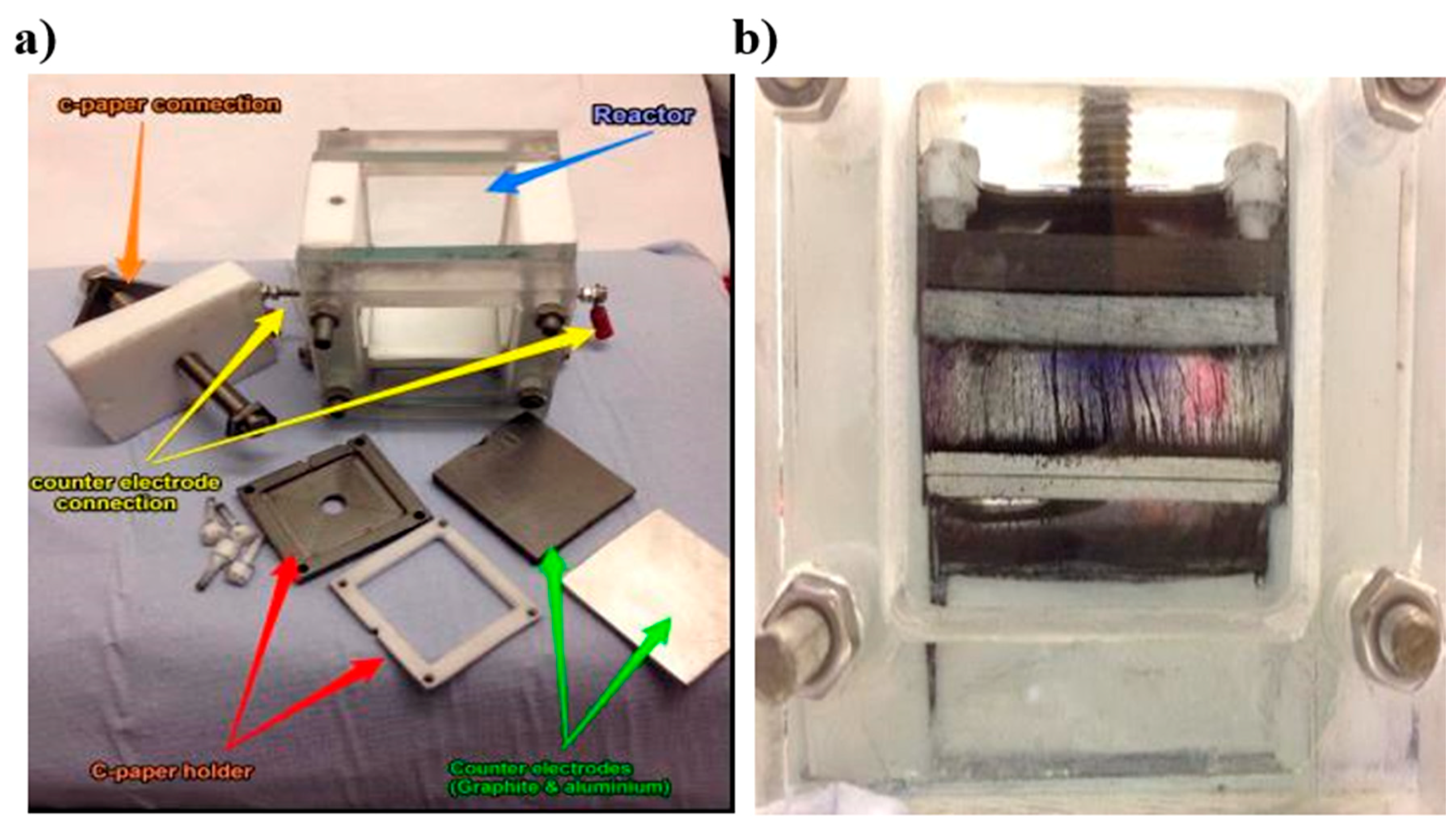
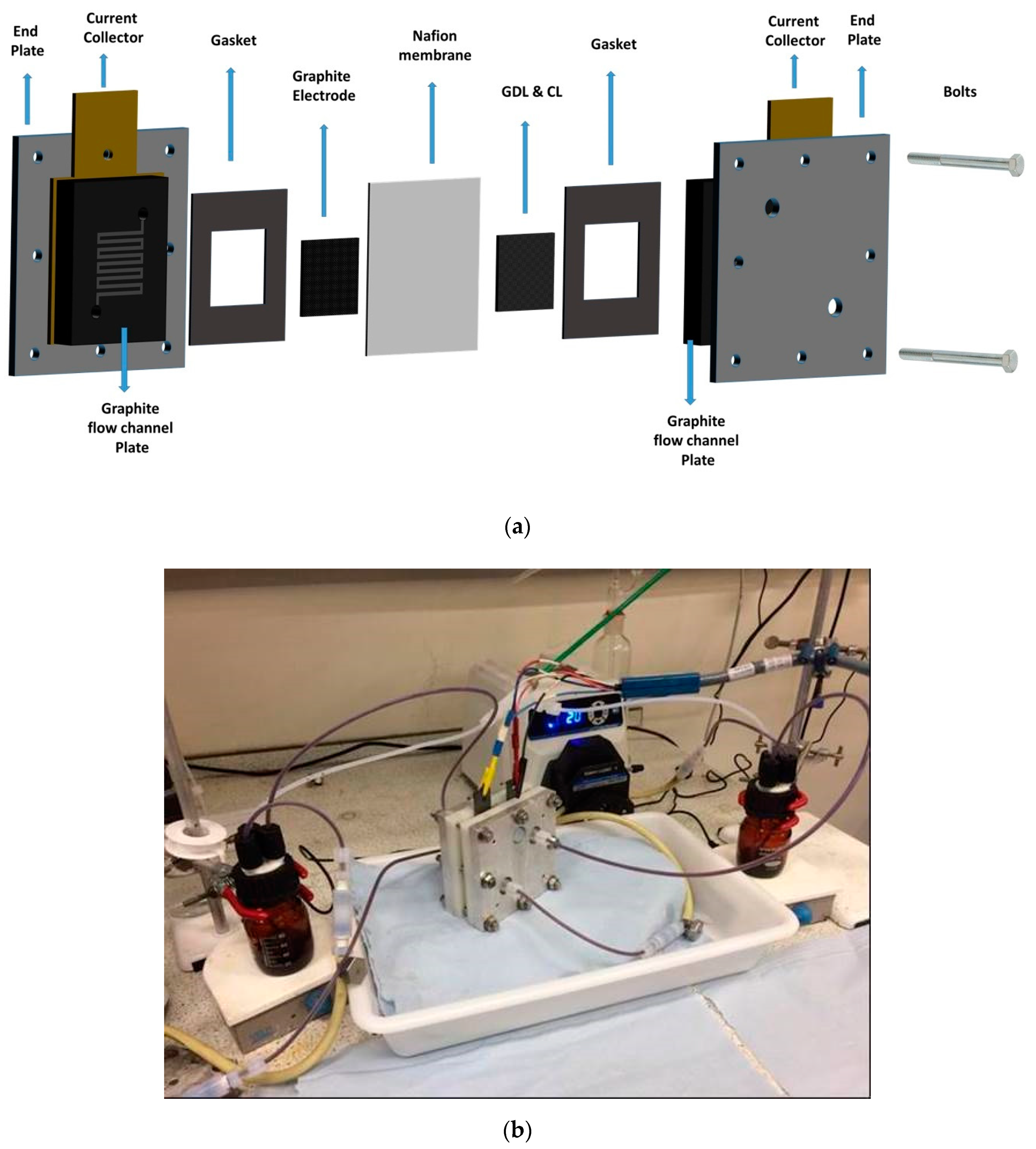
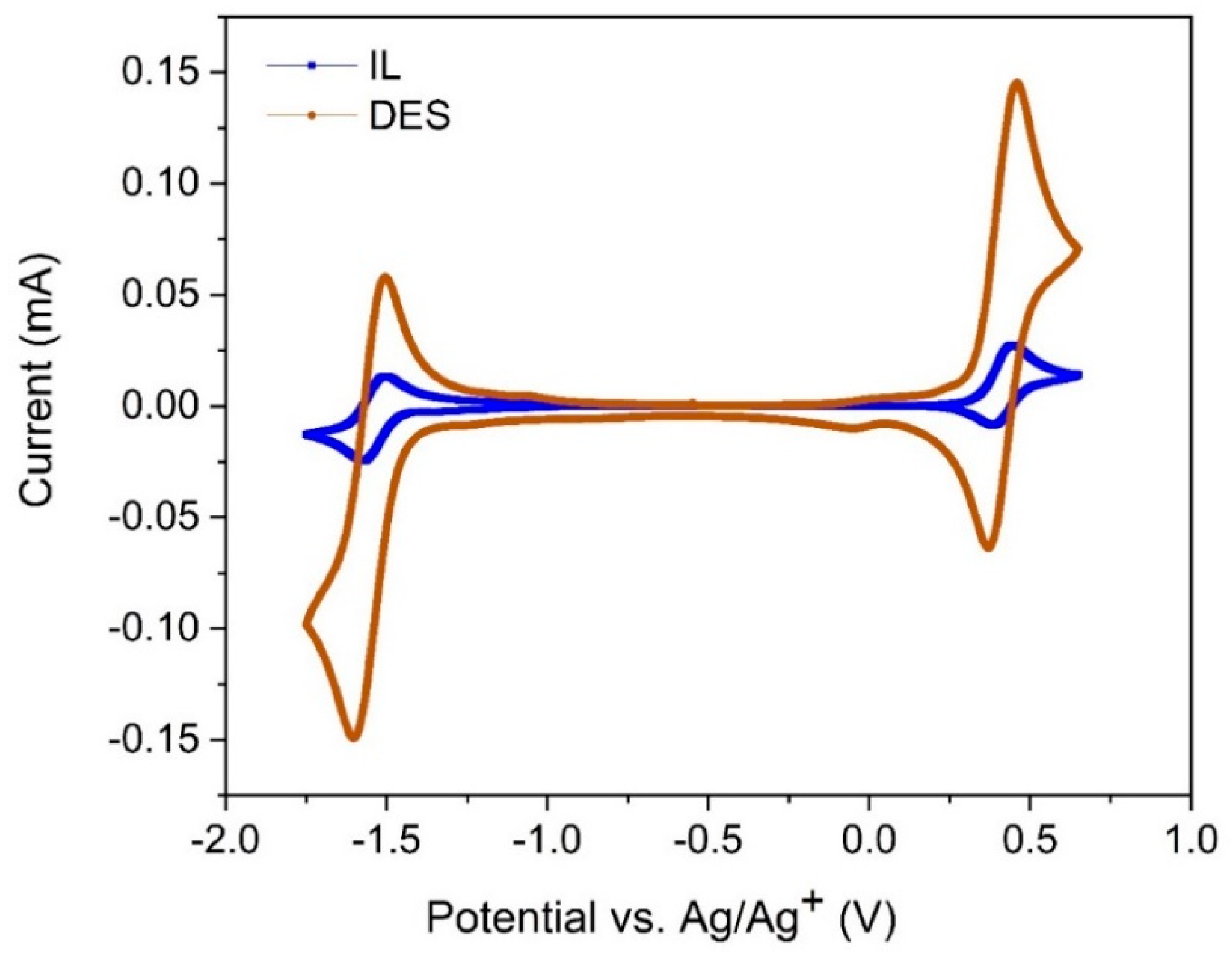
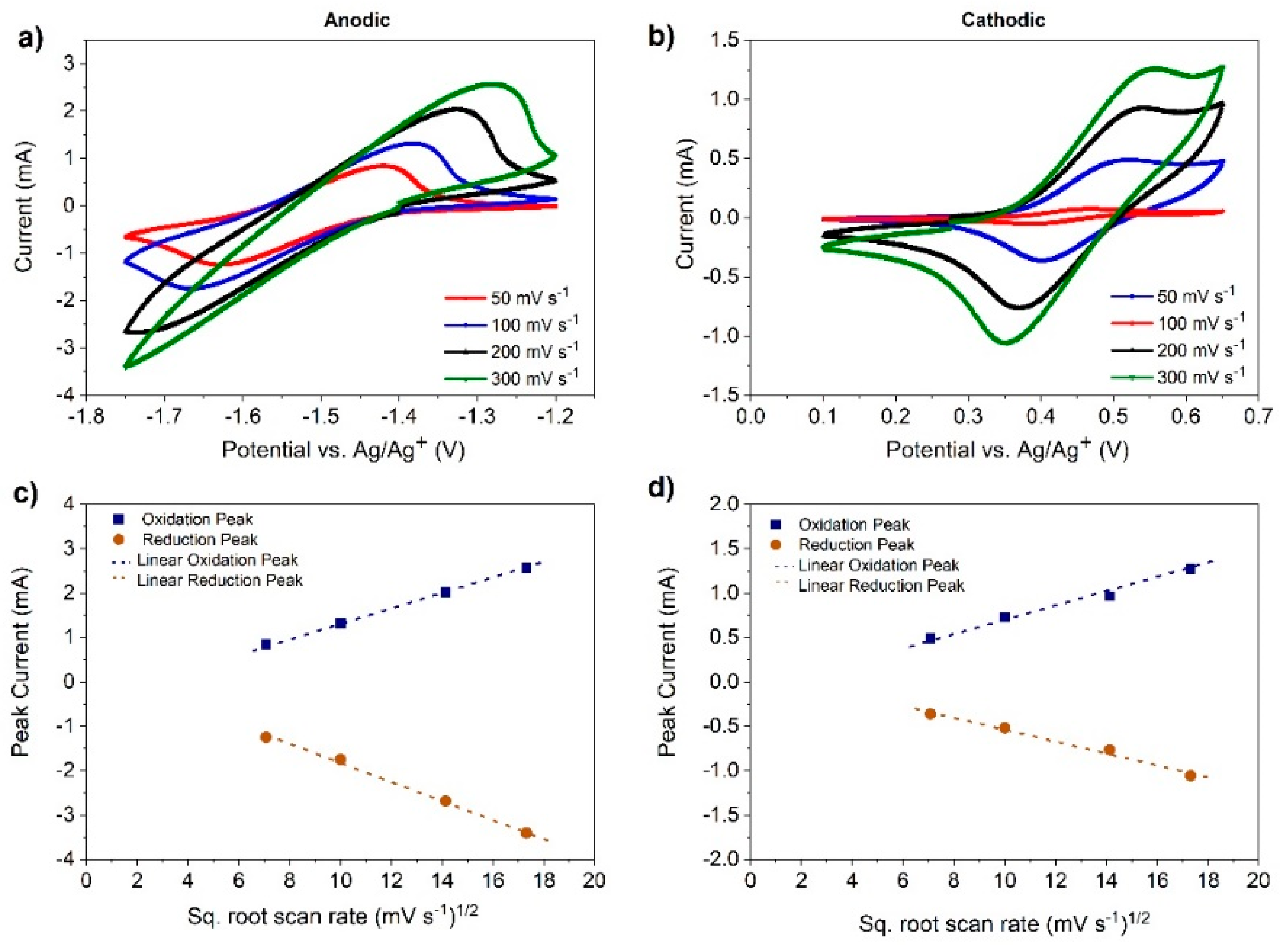
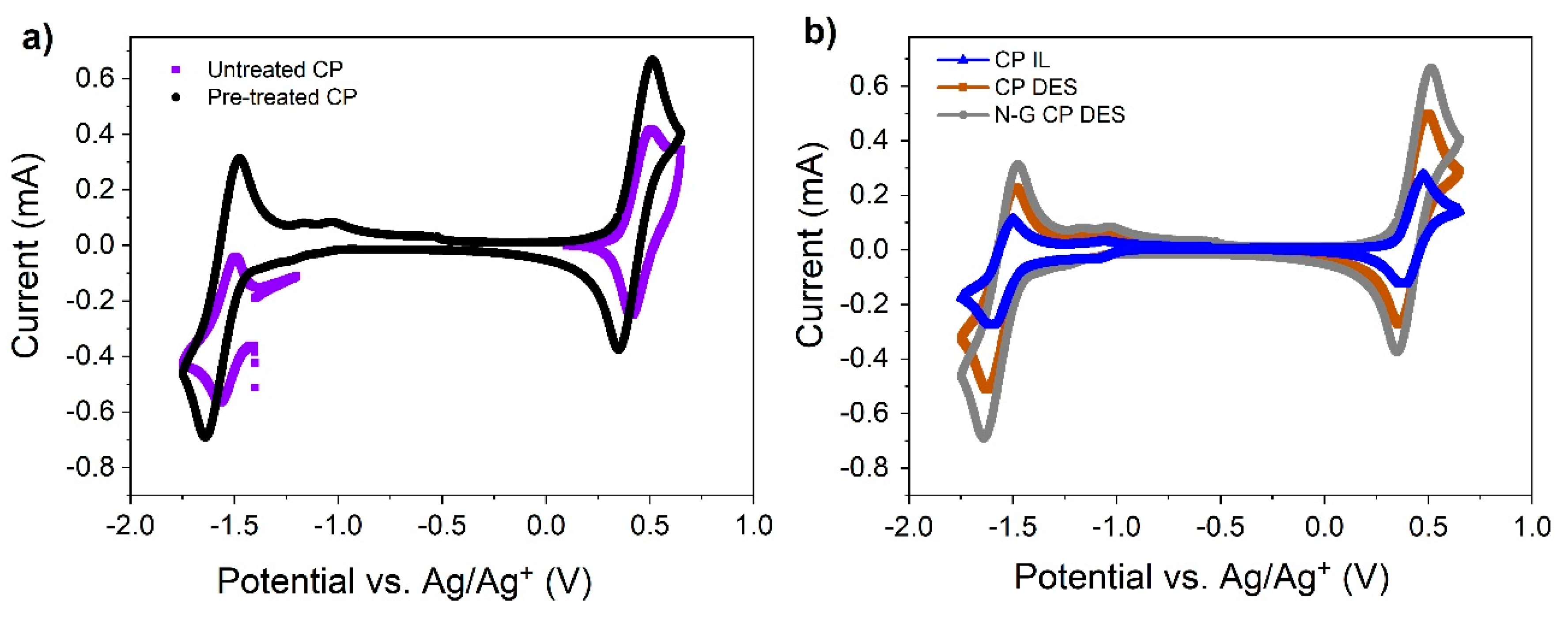
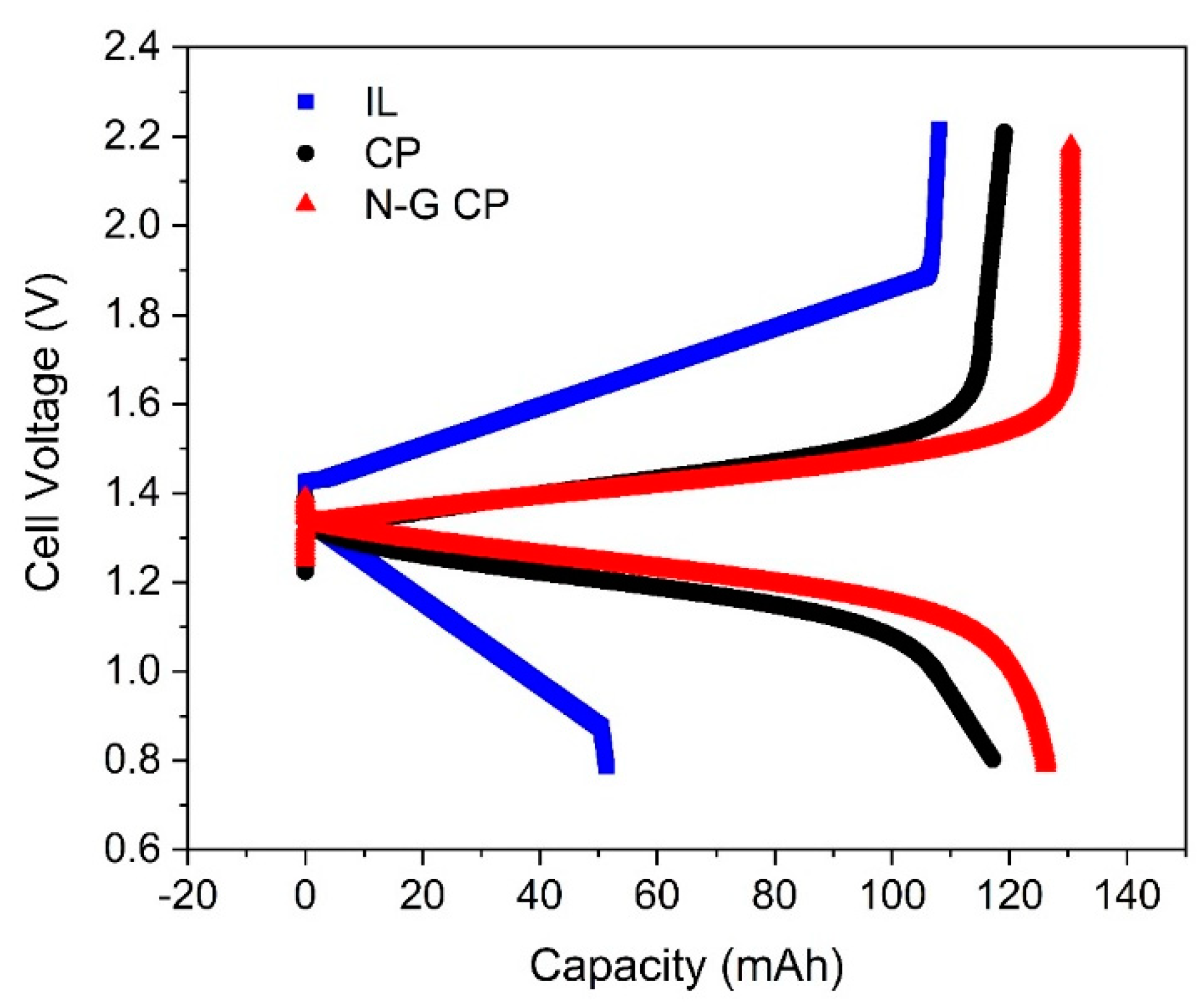
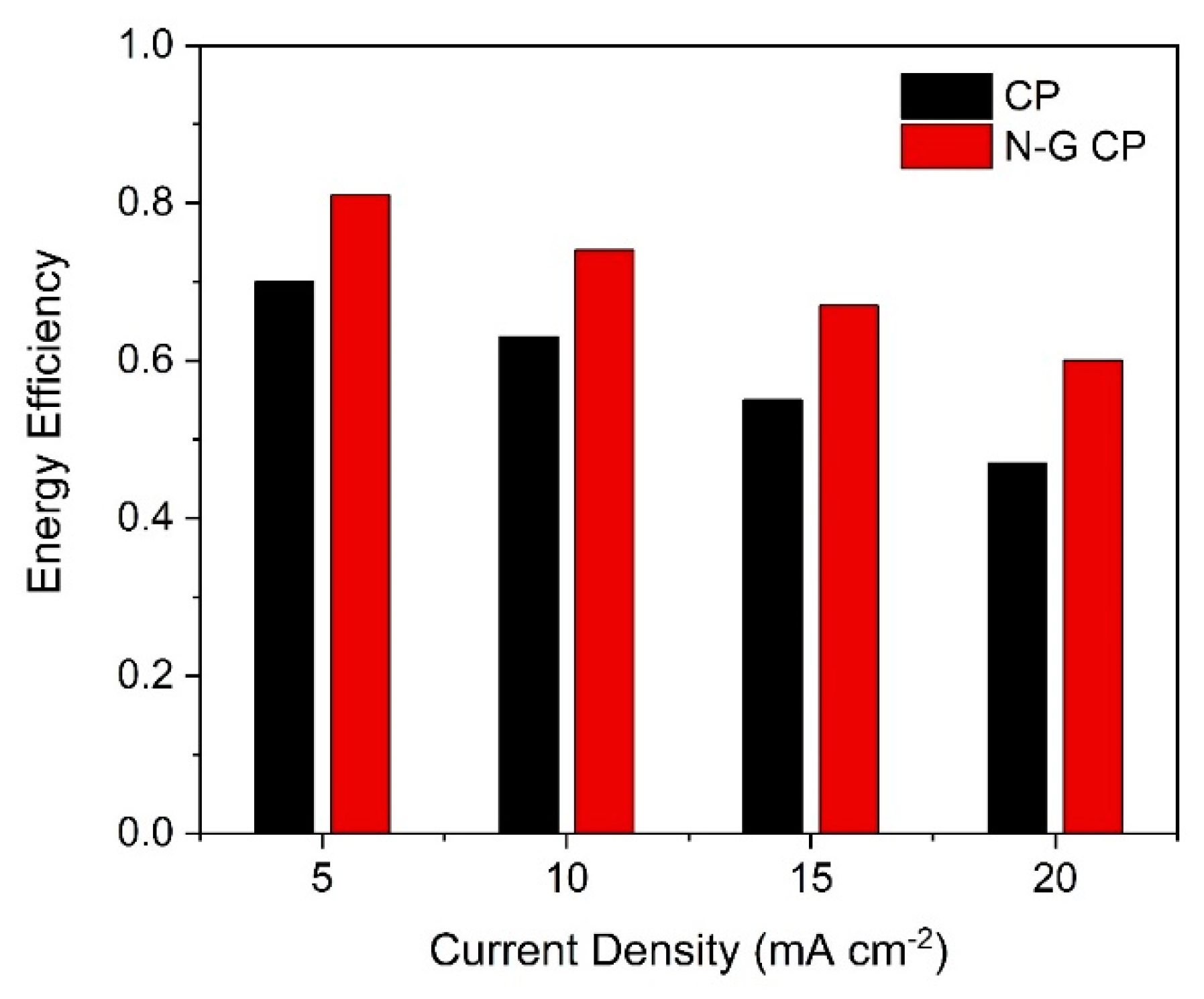
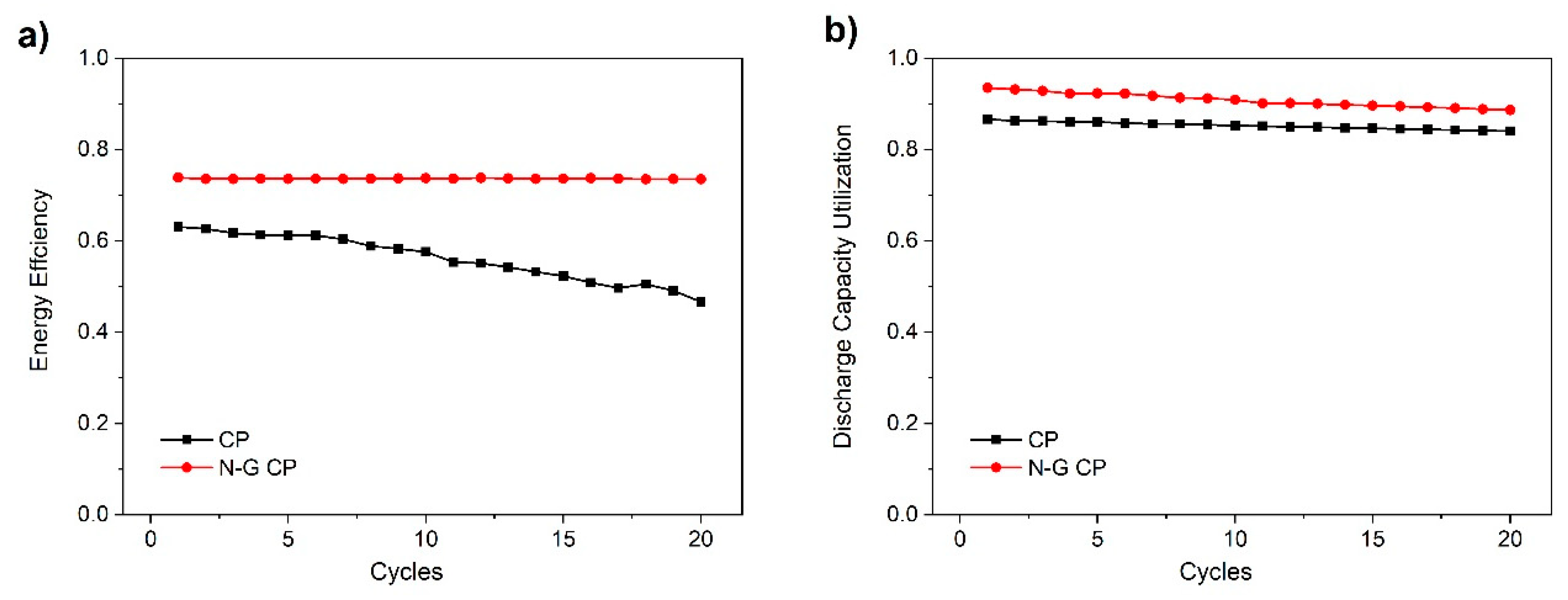
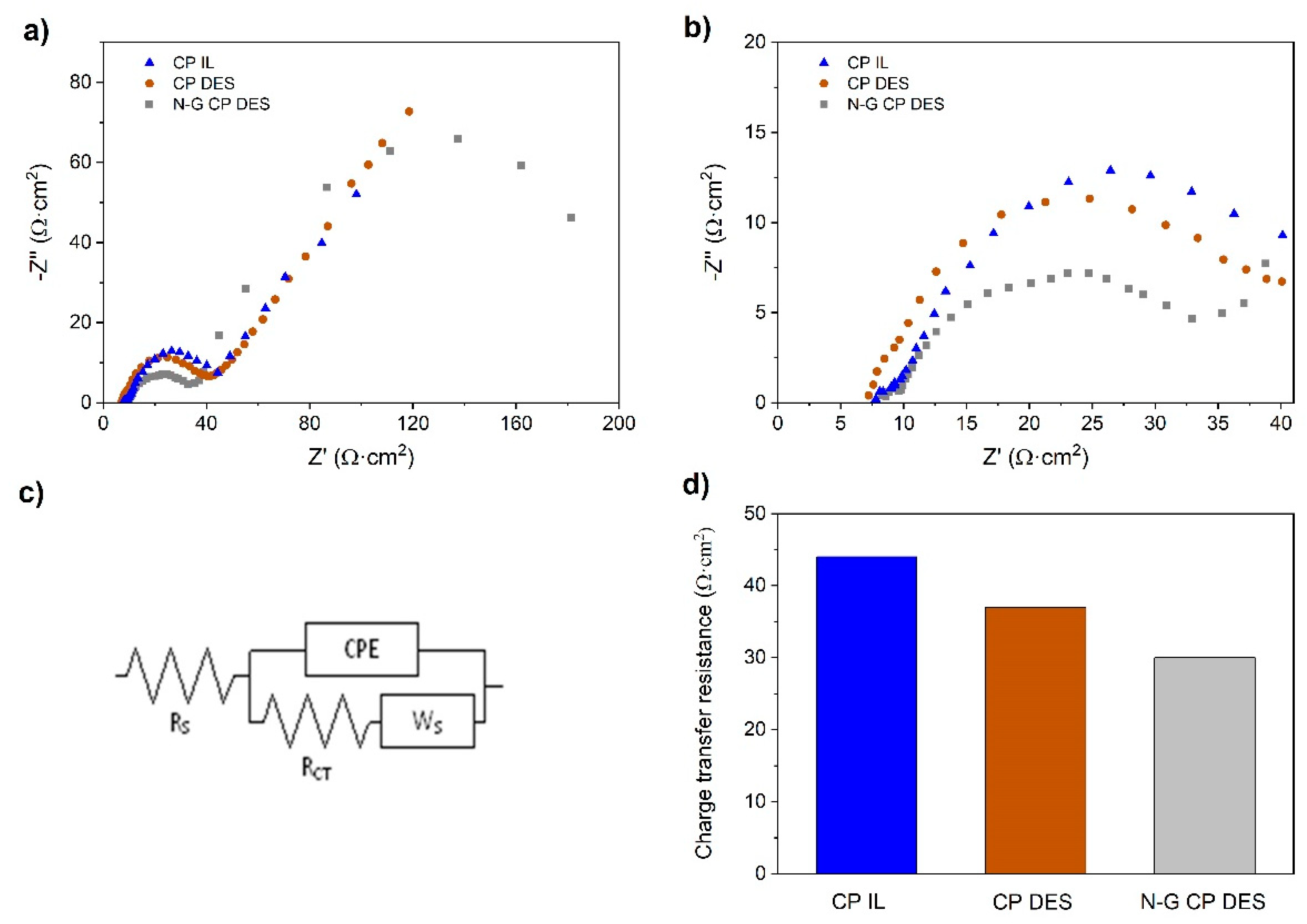
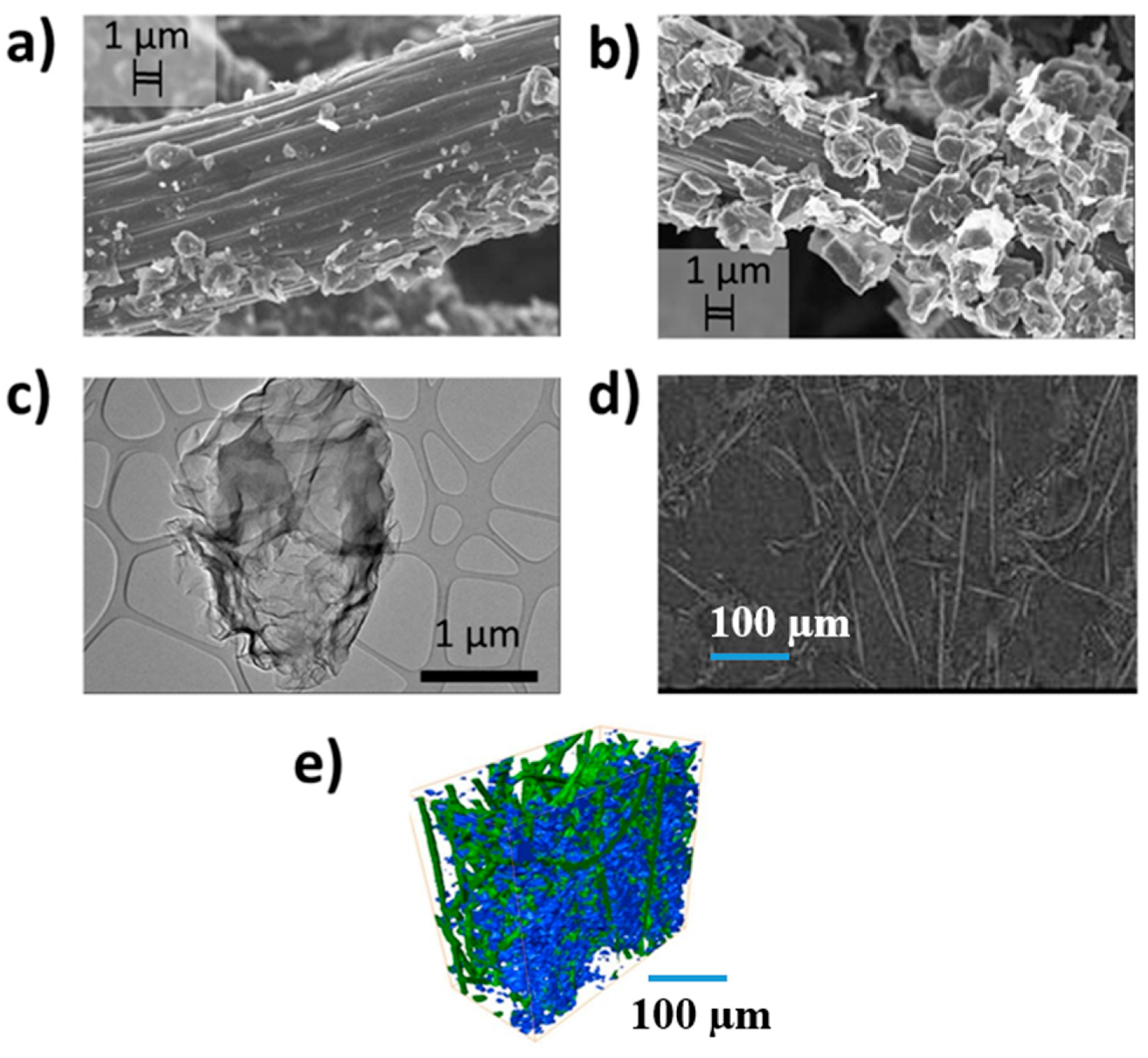
| Ionic Liquid | Price (US$g−1) | Solubility of Vacac (M) | Viscosity (mPa s) | Conductivity (mS cm−1) | Potential Window (V) | Reference |
|---|---|---|---|---|---|---|
| 1-ethyl-methylimidazolium tricyanomethanide | 1.6 | 1.00 | 18.0 | 27.0 | 2.9 | This work |
| 1-ethyl-3-methylimidazolium trifluoromethanesulfonate | 19.0 | 0.50 | 43.8 | 8.9 | 2.3 | [14] |
| 1-butyl-3-methylimidazolium chloride | 9.0 | 0.20 | 64.0 | 0.5 | 3.0 | [51] |
| DES (1:2 eutectic of choline chloride and ethylene glycol—ethaline) | 15.0 | 0.25 | 36.0 | 7.6 | 3.2 | This work and [37,38] |
| CV Scan Rate/(V·s−1) | IL (from Figure 4) | DES Results Reproduced from a Previous Investigation [15] | ||||||
|---|---|---|---|---|---|---|---|---|
| ipa/ipc for Equation (1) | ΔEp/(mV) for Equation (1) | ipa/ipc for Equation (2) | ΔEp/(mV) for Equation (2) | ipa/ipc for Equation (1) | ΔEp/(mV) for Equation (1) | ipa/ipc for Equation (2) | ΔEp/(mV) for Equation (2) | |
| 0.05 | 1.32 | 120 | 0.75 | 90 | 0.97 | 65 | 1.10 | 65 |
| 0.1 | 1.30 | 130 | 0.77 | 100 | 1.03 | 70 | 1.02 | 68 |
| 0.2 | 1.30 | 140 | 0.79 | 120 | 1.08 | 75 | 0.99 | 75 |
| 0.3 | 1.31 | 171 | 0.80 | 140 | 1.15 | 85 | 0.98 | 80 |
| Electrode Sample | Volume of Fibers (vol. %) | Nodal Carbon in CP and Carbon from EPD (vol. %) | Porosity (vol. %) | Total Specific Surface Area (µm2/µm3) | ECSA (µm2 µm−3) |
|---|---|---|---|---|---|
| Pristine CP | 9.35 | 0.95 | 89.70 | 0.81 | 0.59 |
| N-G CP | 9.47 | 1.87 | 86.80 | 1.10 | 0.73 |
© 2020 by the authors. Licensee MDPI, Basel, Switzerland. This article is an open access article distributed under the terms and conditions of the Creative Commons Attribution (CC BY) license (http://creativecommons.org/licenses/by/4.0/).
Share and Cite
Chakrabarti, B.; Rubio-Garcia, J.; Kalamaras, E.; Yufit, V.; Tariq, F.; Low, C.T.J.; Kucernak, A.; Brandon, N. Evaluation of a Non-Aqueous Vanadium Redox Flow Battery Using a Deep Eutectic Solvent and Graphene-Modified Carbon Electrodes via Electrophoretic Deposition. Batteries 2020, 6, 38. https://doi.org/10.3390/batteries6030038
Chakrabarti B, Rubio-Garcia J, Kalamaras E, Yufit V, Tariq F, Low CTJ, Kucernak A, Brandon N. Evaluation of a Non-Aqueous Vanadium Redox Flow Battery Using a Deep Eutectic Solvent and Graphene-Modified Carbon Electrodes via Electrophoretic Deposition. Batteries. 2020; 6(3):38. https://doi.org/10.3390/batteries6030038
Chicago/Turabian StyleChakrabarti, Barun, Javier Rubio-Garcia, Evangelos Kalamaras, Vladimir Yufit, Farid Tariq, Chee Tong John Low, Anthony Kucernak, and Nigel Brandon. 2020. "Evaluation of a Non-Aqueous Vanadium Redox Flow Battery Using a Deep Eutectic Solvent and Graphene-Modified Carbon Electrodes via Electrophoretic Deposition" Batteries 6, no. 3: 38. https://doi.org/10.3390/batteries6030038
APA StyleChakrabarti, B., Rubio-Garcia, J., Kalamaras, E., Yufit, V., Tariq, F., Low, C. T. J., Kucernak, A., & Brandon, N. (2020). Evaluation of a Non-Aqueous Vanadium Redox Flow Battery Using a Deep Eutectic Solvent and Graphene-Modified Carbon Electrodes via Electrophoretic Deposition. Batteries, 6(3), 38. https://doi.org/10.3390/batteries6030038







